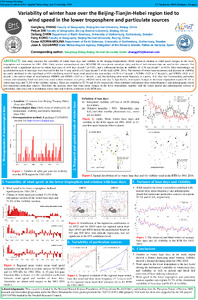Por favor, use este identificador para citar o enlazar este ítem:
http://hdl.handle.net/20.500.11765/11988
Variability of winter haze over the Beijing-Tianjin-Hebei region tied to wind speed in the lower troposphere and particulate sources [Póster]
| Título : | Variability of winter haze over the Beijing-Tianjin-Hebei region tied to wind speed in the lower troposphere and particulate sources [Póster] |
| Autor : | Zhang, Gangfeng; Shi, Peijun; Chen, Deliang; Kong, Feng; Azorín Molina, César; Guijarro Pastor, José Antonio


|
| Palabras clave : | Winter haze days; Visibility; Wind speed changes; Lower troposphere; Dust storm frequency; Fossil fuel emissions |
| Fecha de publicación : | 2018 |
| Citación : | EMS Annual Meeting (2018) |
| Versión del editor: | https://dx.doi.org/10.13140/RG.2.2.10796.31360 |
| Resumen : | This study analyzes the variability of winter haze days and visibility in the Beijing-Tianjin-Hebei (BTH) region in relation to wind speed changes in the lower troposphere and emissions for 1961-2014. Daily surface meteorological data, NCEP/NCAR atmospheric reanalysis data, and fossil fuel emission data are used in this research. The results reveal a significant increase in winter haze days of +0.8 days decade-1 (p<0.01), and a subsequent decline in visibility of-1.56 km decade-1 (p<0.01). Most interestingly, an accelerated increase in haze days was observed for the last 11-year period (+8.3 days decade-1) of the study (2004-2014). The increase of winter haze occurrence and decrease in visibility are partly attributed to: the significant (p<0.01) declining trend of mean wind speed at the near-surface (-0.19 m s-1 decade-1), 925hPa (-0.23 m s-1 decade-1), and 850hPa (-0.21 m s-1 decade-1); the vertical shear of wind between 1000hPa and 850hPa (-0.07 m s-1 decade-1); and, the declining (dust storm frequency as a proxy,-0.41 days dec-1) surrounding particulate sources and increasing fossil fuel emissions (total carbon emission as a proxy, +4820.6 metric tons dec-1). Specifically, wind speed changes in the lower troposphere explain 41.3% of winter haze days and 71.2% of the visibility variance. These are extended to 51.7% and 81.6% respectively when combined with natural (dust storm frequency) and anthropogenic (fossil fuel emissions) particulate sources. Therefore, the analyses show that wind speed changes in the lower troposphere, together with the varied natural and anthropogenic sources of particulates, play a key role in modulating winter haze and visibility conditions in the BTH area. |
| Descripción : | Póster presentado en: EMS Annual Meeting - European Conference for Applied Meteorology and Climatology 2018, celebrado en Budapest del 3 al 7 de septiembre de 2018. |
| Patrocinador: | This research is funded by the National Natural Science Foundation of China (Grant No.41621061), and funding from the European Union’s Horizon 2020 research and innovation programme under the Marie Skłodowska-Curie grant agreement no. 703733 (STILLING project). This work has been also supported by the VR Project (2017-03780) funded by the Swedish Research Council. |
| URI : | http://hdl.handle.net/20.500.11765/11988 |
| Colecciones: | EMS Annual Meeting and European Conference on Applications of Meteorology - Póster |
Ficheros en este ítem:
| Fichero | Descripción | Tamaño | Formato | ||
|---|---|---|---|---|---|
| EMSposter-GangfengZha... | 1,19 MB | Adobe PDF |  Visualizar/Abrir |
Los ítems de Arcimis están protegidos por una Licencia Creative Commons, salvo que se indique lo contrario.





